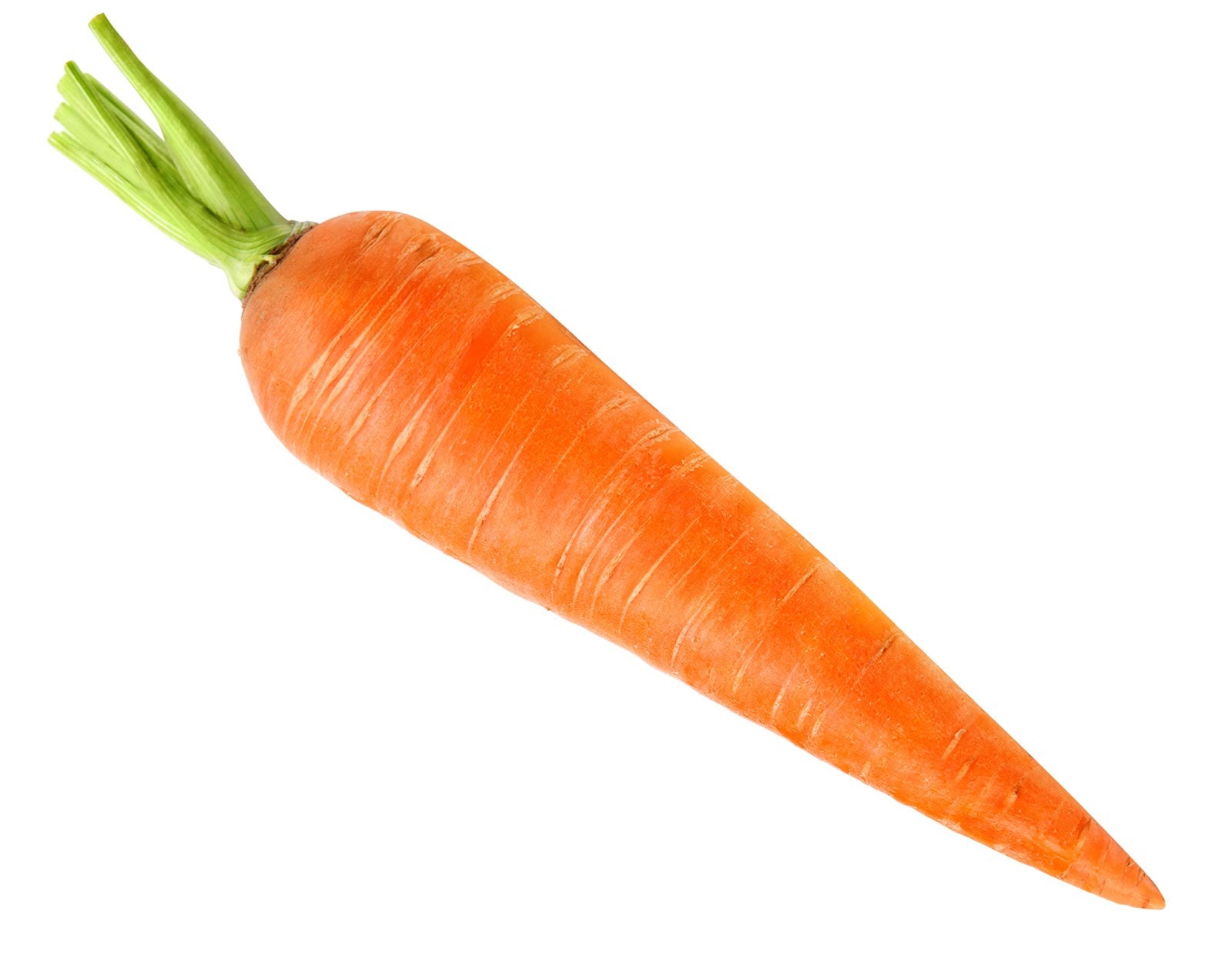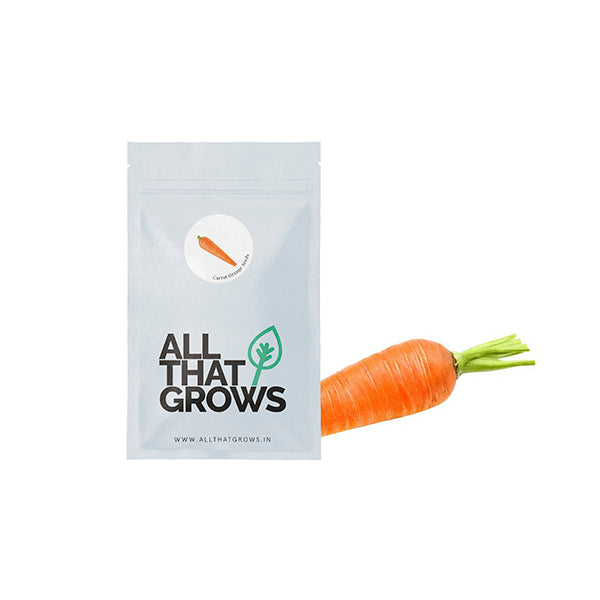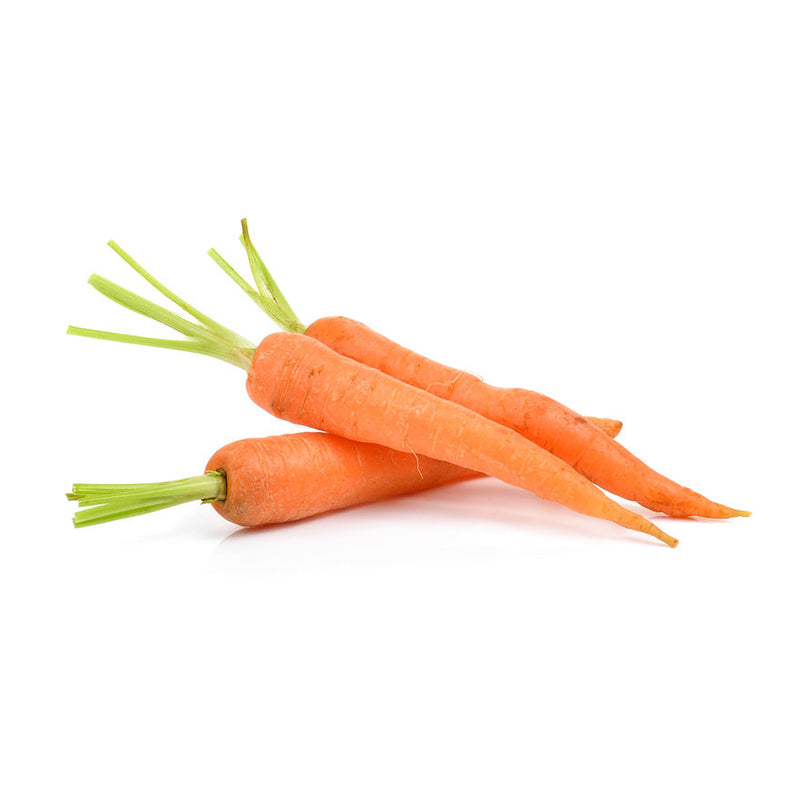





Carrot Orange Seeds
Grow this with
Seed Type : Non-Hybrid, Open Pollinated and Non-GMO
Root Color : Bright orange
Root Length : 6 to 7 inchesRoot Characteristics : Pure cylindrical, blunt end, non hairy, thick, uniform in shape
Specifications : Sweet, suitable for distant transportation
- SOWING
TIMEGrows well in summer
for harvest in fall to winter - Sowing
DistanceSow the seeds in a line, very near to each other keeping the line distance 12 inches
- Fruit
WeightN/A
- Fruit
ShapePure cylindrical with
blunt ends - Days to
maturityEarly, after 75-80 days
from sowing.
- Details
- How to sow
- Reviews
The dietary significance of carrots has been emphasized enough. Every child has grown up hearing the importance of eating carrots and its nourishing properties. It is a vegetable which offers the necessary Carotene for Vitamin A in abundance and so many other vitamins and nutrients which are indispensable for the human body to perform optimally. Whether it's your vision, your immune system, your gut, or your skin, eating carrots can prove exceptionally beneficial for all these systems. So having these health bombs in your kitchen gardens and growing a lovely, healthful orange variety not only makes sense but a lot of difference to the nutrition value of your meals. Even historically, carrots have been known to be proven health power foods and are abundantly found in many cuisines around the world. Native to Europe, Southwest Asia, and the middle East, carrots are in actuality ubiquitous. They belong to the Apiaceae or Umbelliferae family which is known to have a distinct fragrance and flavors. The taproot makes a great staple for salads, can be cooked with other vegetables, eaten raw, steamed, blanched, sauteed, or in soup or dessert form. The sweet-bland taste of carrot makes it a great additive to any special dish or culinary experiment.
You and your family would love having carrots grown right in your backyard! So why not get started. Shop with us!
Planting instructions
Carrot seeds should be planted 0.4 inches deep into the soil. This ensures that the seeds start germinating within 2-3 weeks. Make sure that each seed is planted at least 6 inches apart from each other.
Thin the plants to about 3 inches apart once the seedlings have grown a few leaves. Your carrot plants should get at least 3-4 hours of sunlight in a day.
Maintain a moderate watering schedule for carrots. Let the top 1cm of the soil layer dry up before watering again.
Growing Requirements
Pests & Diseases
Pests: Willow Carrot Aphid, Carrot Rust Fly, Carrot Weevil, Flea Beetle, Root-Knot Nematodes. Diseases: Alternaria Leaf Blight, Cercospora Leaf Blight, Cottony Rot, Downy Mildew, Powdery Mildew, Bacterial Leaf Blight, Soft Rot, Cavity Spot, Damping-off. Watering the plants in the morning helps to avoid fungal diseases. Companion plants significantly reduce incoming pests on your crops. Watering down the plants with a strong stream of water followed by an application of diluted neem or castor oil on the pest-affected parts of the plant will help to get rid of them.
soil
Sandy, well-drained loamy soil. Clear trash, rocks, and large pieces of tree bark from the soil. Maintain the pH level of the soil at 6
spot
Partial sunlight; 3-4 hours of sunlight in a day.
Temperature
Carrots require an ideal germination temperature between 20°C to 30°C.
watering
Moderate watering; allow the top 0.4 inch of soil to dry up before you water the plants again.
how to harvest
Carrots take about 2-3 months to mature completely. When the diameter of the carrot tops becomes 0.5 inch, that’s when you need to harvest the carrots.
Dig out an area of soil around the roots, grip the carrot firmly and pull it out. Do not pull out the fruit by holding onto the foliage. You may end up with just the leaves. Once you are done with the harvesting, collect all the carrots in a container and wash them thoroughly before consuming them.
After washing the carrots thoroughly, chop off the excess foliage from the carrot head and place them in a container filled with water. Keep this container in the refrigerator so that your carrots remain fresh and ready to use whenever you want.

The productiveness of any seed we sell is subject to your local climatic conditions*, the sowing method you adopt, and your commitment to the planting process. We give no warranty, expressed or implied, and are in no way responsible for the produce.
Please note that all our seasonal recommendations/ sowing information is as per the local climatic conditions. *For more information on the optimum conditions required for growing seeds in your region, please contact us at, hello@allthatgrows.in or Whatsapp us at, +91 8544865077
Questions & Answers
Have a Question?
Be the first to ask a question about this.






Carrot Orange Seeds
Seed Type : Non-Hybrid, Open Pollinated and Non-GMO
Root Color : Bright orange
Root Length : 6 to 7 inchesRoot Characteristics : Pure cylindrical, blunt end, non hairy, thick, uniform in shape
Specifications : Sweet, suitable for distant transportation
Grow this with
The dietary significance of carrots has been emphasized enough. Every child has grown up hearing the importance of eating carrots and its nourishing properties. It is a vegetable which offers the necessary Carotene for Vitamin A in abundance and so many other vitamins and nutrients which are indispensable for the human body to perform optimally. Whether it's your vision, your immune system, your gut, or your skin, eating carrots can prove exceptionally beneficial for all these systems. So having these health bombs in your kitchen gardens and growing a lovely, healthful orange variety not only makes sense but a lot of difference to the nutrition value of your meals. Even historically, carrots have been known to be proven health power foods and are abundantly found in many cuisines around the world. Native to Europe, Southwest Asia, and the middle East, carrots are in actuality ubiquitous. They belong to the Apiaceae or Umbelliferae family which is known to have a distinct fragrance and flavors. The taproot makes a great staple for salads, can be cooked with other vegetables, eaten raw, steamed, blanched, sauteed, or in soup or dessert form. The sweet-bland taste of carrot makes it a great additive to any special dish or culinary experiment.
You and your family would love having carrots grown right in your backyard! So why not get started. Shop with us!
Seed Type : Non-Hybrid, Open Pollinated and Non-GMO
Root Color : Bright orange
Root Length : 6 to 7 inchesRoot Characteristics : Pure cylindrical, blunt end, non hairy, thick, uniform in shape
Specifications : Sweet, suitable for distant transportation
- SOWING
TIMEGrows well in summer
for harvest in fall to winter - Sowing
DistanceSow the seeds in a line, very near to each other keeping the line distance 12 inches
- Fruit
WeightN/A
- Fruit
ShapePure cylindrical with
blunt ends - Days to
maturityEarly, after 75-80 days
from sowing.
Planting instructions
Carrot seeds should be planted 0.4 inches deep into the soil. This ensures that the seeds start germinating within 2-3 weeks. Make sure that each seed is planted at least 6 inches apart from each other.
Thin the plants to about 3 inches apart once the seedlings have grown a few leaves. Your carrot plants should get at least 3-4 hours of sunlight in a day.
Maintain a moderate watering schedule for carrots. Let the top 1cm of the soil layer dry up before watering again.
Growing Requirements
Pests & Diseases
Pests: Willow Carrot Aphid, Carrot Rust Fly, Carrot Weevil, Flea Beetle, Root-Knot Nematodes. Diseases: Alternaria Leaf Blight, Cercospora Leaf Blight, Cottony Rot, Downy Mildew, Powdery Mildew, Bacterial Leaf Blight, Soft Rot, Cavity Spot, Damping-off. Watering the plants in the morning helps to avoid fungal diseases. Companion plants significantly reduce incoming pests on your crops. Watering down the plants with a strong stream of water followed by an application of diluted neem or castor oil on the pest-affected parts of the plant will help to get rid of them.
soil
Sandy, well-drained loamy soil. Clear trash, rocks, and large pieces of tree bark from the soil. Maintain the pH level of the soil at 6
spot
Partial sunlight; 3-4 hours of sunlight in a day.
Temperature
Carrots require an ideal germination temperature between 20°C to 30°C.
watering
Moderate watering; allow the top 0.4 inch of soil to dry up before you water the plants again.
how to harvest
Carrots take about 2-3 months to mature completely. When the diameter of the carrot tops becomes 0.5 inch, that’s when you need to harvest the carrots.
Dig out an area of soil around the roots, grip the carrot firmly and pull it out. Do not pull out the fruit by holding onto the foliage. You may end up with just the leaves. Once you are done with the harvesting, collect all the carrots in a container and wash them thoroughly before consuming them.
After washing the carrots thoroughly, chop off the excess foliage from the carrot head and place them in a container filled with water. Keep this container in the refrigerator so that your carrots remain fresh and ready to use whenever you want.



 Sign In
Sign In








